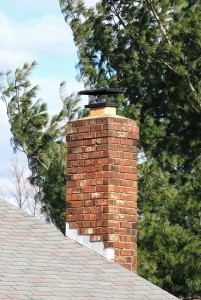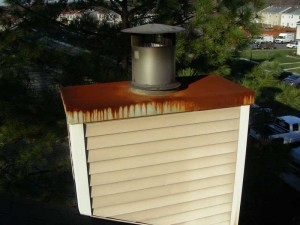Summer is on its way in, bringing heat, moisture, high winds, and powerful storms. What this means for your chimney is that it is about to be put to the test by Mother Nature.

Even if you’re a responsible homeowner and never forget to schedule your annual inspection and sweeping, you could experience complications and water damage as a result of a high-wind and high-precipitation storm. Strong winds have been known to remove chimney caps and pry away flashing, and heavy rain can bombard your system, causing all sorts of internal and external damage. That’s why it is wise to schedule a professional inspection after any severe storm.
The Most Common Chimney System Damages Resulting From Storms Are:
- Crown Damage – The crown of your chimney is the concrete layer that shields it from water, wind, debris, and animals. If your crown is not constructed of the proper materials or was not made the proper thickness, heavy rainfall can cause crumbling and deterioration. A deteriorating crown can allow water and other debris to enter directly into your chimney system and cause water damage and internal decay.
- Flashing Damage – Flashing refers to the metal sheets that line the area where your chimney and roof intersect. This area of the home is particularly vulnerable to water damage, which is why proper flashing installation and maintenance is so important. If your flashing was not properly installed, there may be gaps and openings between the roof and the chimney, where heavy rain can easily penetrate. Improper installation may also leave areas on the surface of the flashing that allow for water to accumulate and corrode. Even if your flashing was properly installed, a storm can cause significant damage and open up the possibility for leaks. Strong winds have been known to pry and pull entire layers of flashing away from and even off of the roof or chimney. Strong winds and storm debris can also dent or bend the flashing, creating areas for water accumulation to rust and eat holes in the individual layers. Once these holes are created, water can continuously penetrate the chimney system.

- Cap Damage or Removal – The cap of the chimney sits directly over the crown, and like the crown, it is designed to keep out wind, water, debris, and animals. Sometimes, the chimney cap is not securely installed, and can come loose during a storm. Even if the cap is securely installed, high winds can loosen or even remove it from the chimney top. Caps can also rust from heavy rain, which can lead to leaks and openings for debris to enter the chimney system.
- Masonry Leaks – The masonry of your chimney is porous and vulnerable to water penetration and damage. During heavy rain and driving winds, water can be forced into the brick and mortar, where it constricts and swells as temperatures change. This process causes deterioration within the masonry, and can significantly shorten the lifespan of your chimney system. However, having your system professionally waterproofed can protect you from these worries.
- Flue Deterioration – If any of the protective areas of your chimney are damaged during a storm, water can access the flue liner, causing rust and corrosion within. As your flue liner decays, it allows moisture, heat, smoke, and gases to enter other areas of your home. Not only can this cause extensive damage to your home and health, it is also a serious fire hazard.
Protecting Your Investment
No matter where you live, it seems that storms are getting stronger and more frequent. To protect your home and family from the effects of water and wind damage, be sure to have your system inspected anytime you experience severe weather. Catching damage early on can save you thousands in repairs, and preserve the life and enjoyment of your chimney system.
If you have any questions or would like to know more about waterproofing or post-storm inspections, please contact us at 410-590-4800!
